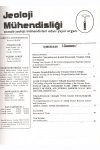
ABSTRACT: Devonian and Jurassic aged metamorphicrocks occur in the studied area. The igneous rocks intruded during the Eocene and Oligocène have affected the Permian limestones, and the skaras been formed metasomatically at this contact. There is a zoning in the éimns comprising the pyroxene-skarns adjacent to igneous rocks and the prnet-skarns adjacent to limestones. The pyroxene-skarns are consisting mainly of diopside and hedenberpte; the garnet-itarns mainly of possukrite and andradite. The Karamadazı contact-metasomatic magnetite deposit is found in this skarn belt. Magnetite is the main ore mineral. Pyrite, chalcopyrite, pyrrhotite seen with the lower quantity, The possible origin of the iron is in the intrusive body, and carried as ferrous-chlorides in the acidic hydrous solutions. The magnetite deposit had been formed by the reactions between the ferrous-chloride bearing=solution and tlie limestone in the oxidizing phase of the metasomatism, The sulfide minerals, however, formed by the sulfide-bearing solutions in the last phase and filled the fissures and the open spaces in the icarn and magnetite, Hie ore body hasa lens-like shape dipping to teh soui!?e.-*st* The grade of the ore is 54 % Fe and U % S, and the proved reserve is 6,4 million tons.
ABSTARCT: In the area of Domoniç, Tavşanlı, Kütahya and Gediz the Tertiary Sedimentary and volcanic rocks are widely distributed; they overlie unconformably the Pre-Tertiary rocks. The first Tertiary sedimentary unit of the region is the Eocene limestones e-posed in a limited area between lıvpnİı and Tunçbîlek, With the neotectonic phase started in the Middle Miocene, graben basins began to form. In the Pliocene, lake and river deposits accumulated in the widely extended basins. Quaternary b represented by the coarse grained river deposits and travertines. Acidic volcanism which started in the latt-Miocene occurs as lavas and pyroclastics till the end of pliocene. In the Pliocene together with this volcanism another volcanism of İntermediıta-basic composition took place, Tunçbîlek, Seyitömer and alabarda basins rave great importance for coal.
View as PDF
ABSTRACT: The results achieved from the gological studies that hava been carried out on the Tertiary aged rock units cropping out in the vicinity of the town of Ayvalık in Balıkesir province are presented and the genetic interpretations of the igneous rocks in terms of plate tectonics are made. In the area under investigation, firs plu= tonic intrusion was the Koiak pluton intruded during Eocene-Oligocene time which was sueeeded by the monzonitic dikes of Maden Adası. Volcanİsm shows five different volcanic periods from late Oligocène to pliocene gi« vîg rise to produce different volcanic materials. Petrochemical analyses carried out on the formations such as Alîbey volcanics (late Oligocène), Hallaçlar formation (Late Oligocene-Early Miocene), Dedetepe formation (Early Miocene), Yuntdağ Völemks (Middle-Late Miocene) and Dededağ volcanics (Early Pliocene) indicated that these volcanics are essentially calcalkaline and partly shoshonitîc showing continental crustal origin,
ABSTRACT: Within the scope of this study, the geologi^l map of Aladaglar region is completed, The widespread Yahyalı, Siyah Aladağ and Minaretepeier Nappes, Basyayla Melange and Yahyalı Granîtoİdes were examined In detail and the nappes separated in to formations and members. Furthermore these units are correlated with similar units of Middle Taurus. Kirazlı, Karsavuran, Ayraklitepe, Yellibel, Kariığmtepe and Koatepe formations which are cosidered as Yahyalı Nappe wera deposited during the Silurian-Triassic period and metamorphosed later. The Kirazlı and Yellibel formations consist of schists but others of carbonate rocks, At the northern part of this nappe, along the lower contact of karlığın formation, irregular skam beltsrelated to granitoid intrusion can be seen, The Siyah Akdağ Nappe Includes Upper Devonian-Jurassic Harabe, Köşkdere, Sarioluk, Zindandere, Dişdöken, Çobankaya and Horçdağı formations. The later one shows cataclastic metamorphism. Major parts of Harabe and Dişdöken formations consist of pelitle rocks and other formations generally of carbonate rocks, In the Triassie Minaretepeler Nappe, three formations were distinguished, Beygiruçuğu formation is formed of pelagic limestones, mar! and mudstones. Meydanyaylaa and Sivrikaya formations almost composed carbonate maerials. Nappes which are divided in to formations and effected from vertical and lateral movements, rave some units simikr to each other. But, İn detail these units show different features in terms of fossil content and lithology.

 TMMOB
TMMOB